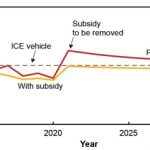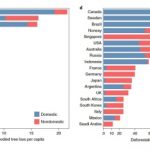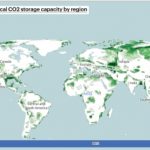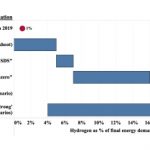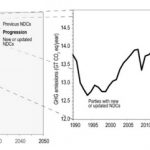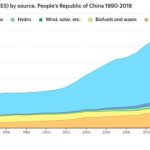By the end of the 2020s China will phase out EV subsidies and instead rely on a mandate imposed on manufacturers to target 40% of car sales being electric by 2030. Nancy Stauffer at MIT reviews a study that estimates the new rules will result in 66m EVs sold in China in the next 10 years. That will move EVs well into the mainstream and have global consequences. According to the study, the total cost of that transition will be 100bn yuan/year … [Read more...]
What is your nation’s “deforestation footprint”? When imports cut down trees somewhere else
Behaviour change is now inextricably linked to the transition and must be part of the world’s emissions reduction strategy, and there are many different types of relevant behaviour and ways to measure the impacts. One is to look at deforestation, caused by chopping down trees to meet our consumer needs. To grasp whose behaviour has to change we need to appreciate to what extent deforestation in places like Brazil, Canada, Liberia, Vietnam etc., … [Read more...]
CCS: Identifying the best underground locations for storing CO2 can take 10 years, so let’s start now
Underground geological formations have more space to store CO2 than we’ll ever need, by orders of magnitude. But the process of assessing the best locations can take up to ten years, so that work needs to start now, say Raimund Malischek and Samantha McCulloch at the IEA. The main constraints are technical (which porous rock formations absorb CO2 most easily, etc.), while the displacement of land use and public acceptance must also be considered. … [Read more...]
“China and Europe – Energy Efficiency, the foundation of our net-zero future” [EVENT highlights and VIDEO]
We present the videos of the third of our three, 4-session workshops on the opportunities for European energy solutions providers to take part in China’s energy transition, held on April 13th and 14th 2021. In this workshop the theme was efficiency, with special reference to finance, buildings, heating and cooling, and smart solutions. Both regions need to go beyond the efficiency "easy wins" so we take a close look at what Europe can offer as … [Read more...]
China: decoupling GDP growth from rising emissions
To set up this week’s important online event (Tuesday 13th & Wednesday 14th April) “China: Carbon Neutral by 2060 -EFFICIENCY FIRST” we have an overview of China’s energy transition. Everyone agrees its performance is critical for the world to achieve the global goal of limiting warming to 1.5C by 2050. China made significant progress in 2020 with policy frameworks, renewable capacity additions and EVs, but it also added 38 GW of new … [Read more...]
Buildings Efficiency in China, and what EU partners should know
To set up our upcoming online event (April 13th & 14th) "China: Carbon Neutral by 2060 -EFFICIENCY FIRST” we look at how Buildings Efficiency is being tackled by Energy Management Contracting (EMC), when an ESCO (energy service company) provides energy retrofit services and gets paid for the future energy savings. The up-front investment cost is recouped over the multi-year lifetime of the service contract by taking a cut of the genuine … [Read more...]
Saudi Arabia’s clean hydrogen plans for converting ambitions into action
The recent Memorandum of Understanding with Germany on clean hydrogen cooperation underlines Saudi Arabia’s ambition in becoming a global powerhouse producer in this field. Governments and industry players are currently considering clean hydrogen as an energy vector with key energy transition roles in an increasingly carbon-constrained world. Hydrogen has the potential to grow into a trillion-dollar commodity market, with enormous opportunities … [Read more...]
“The Role of Gas” in Europe and China: EVENT VIDEO on security of supply, gas to power, competitive markets & renewable gases
We present the videos of the second of our three, 4-session workshops on the opportunities for European energy solutions providers to take part in China's energy transition. In this workshop, held in February, we looked at gas. Demand in China is expected to keep growing. That’s because China doesn’t just need to replace coal, it simply needs more energy. Europe’s gas sector has decades of relevant experience, technology, policy, planning and … [Read more...]
Updated NDCs: World committing to 0.5% emissions cuts by 2030. It should be 45%
The latest national climate pledges, submitted over the new year, show that the world is nowhere near meeting our emissions reductions goals. Analysis of the 48 updated “nationally determined contributions” (NDCs) submitted so far (everyone must submit by the end of this year), covering nations responsible for 29% of global emissions, shows we will have 0.5% lower emissions in 2030 compared to 2010. That’s way off the target 45% reduction needed. … [Read more...]
EU, U.S. exploring new sources of Rare Earth Minerals, should China limit exports
Reports are emerging that China is considering the restriction of the export of rare earth minerals, as a result of tensions with the U.S. Given China controls around 80% of global supply it would have severe consequences for not just advanced military applications (the presumed primary target) but also clean energy technologies like EVs and wind turbines. However, if the threat is carried out, Lukas Trakimavičius explains how this could backfire … [Read more...]
Industrial Clusters: the logic of co-location now has a new driver, net-zero emissions
Industrial clusters locate plants and factories in one area to share resources, problems and solutions. They already have a long history of collaboration. But the logic of co-location now has a new driver: net-zero emissions. The sectors can range from heavy industry (e.g. steel and cement) to light (food, paper, etc.) The challenge is to make the most of new clean technologies and processes, and at the same time maintain or increase … [Read more...]
Asia’s record Gas prices expose the need for faster market reform
After record lows in mid-2020, Asian spot prices for LNG rose tenfold to reach record highs in January 2021. This volatility is an obstacle to the development of the gas infrastructure that’s essential to the region where demand for gas is growing, explain Jean-Baptiste Dubreuil and Gergely Molnar at the IEA. There were multiple causes for the price spike, including the cold winter, limits to nuclear and coal generation, and outages at regional … [Read more...]
How to create four major regional Gas hubs in Russia
Kamil Sobczak at the Russian Gas Society has co-authored a report, “Opportunities and prospects for the development of gas hubs in Russia”, which he summarises here. It scopes out what is needed to create four major gas hubs in the Far East, North West, Central and Southern Russia. The plan will help develop and modernise Russia’s gas sector as well as increase exports. Transparency in prices and transaction volumes will be essential to create … [Read more...]
China’s 14th Five-Year Plan will reshape its growing Gas sector
Demand for natural gas in China is set to continue its rise, increasing by 7% to 9% annually to reach up to 500 bcm by 2025, explains Sylvie Cornot-Gandolphe at the IFRI Centre for Energy & Climate. Domestic gas production has continued its significant growth too, driven by a surge in shale gas. Even then, gas imports – both pipeline and LNG - should increase to fulfil the rising supply/demand gap. This growing importance of gas in the energy … [Read more...]
Decarbonising Industry is key to China’s net-zero strategy
China has committed to a CO2 emissions peak before 2030 and carbon neutrality before 2060. It’s 14th 5-year plan will be released in March, followed by sector-oriented plans. For the first time it will include a dedicated plan addressing climate change. Dolf Gielen, Yong Chen and Paul Durrant at IRENA start by laying out China’s energy mix for scrutiny, then dive into its industrial sector which accounts for 60% of gross final energy use. Success … [Read more...]
- « Previous Page
- 1
- …
- 7
- 8
- 9
- 10
- 11
- …
- 15
- Next Page »


